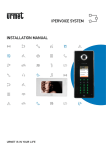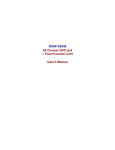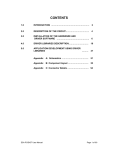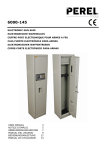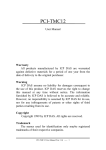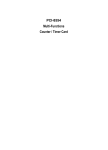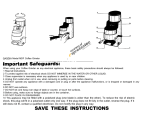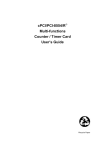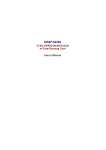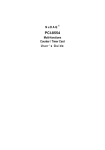Download PCI8282 User's Manual
Transcript
DASP-52010 10 Channel Counter/Timer Card User’s Manual Disclaimers The information in this manual has been carefully checked and is believed to be accurate. AXIOMTEK Co., Ltd. assumes no responsibility for any infringements of patents or other rights of third parties which may result from its use. AXIOMTEK assumes no responsibility for any inaccuracies that may be contained in this document. AXIOMTEK makes no commitment to update or to keep current the information contained in this manual. AXIOMTEK reserves the right to make improvements to this document and/or product at any time and without notice. No part of this document may be reproduced, stored in a retrieval system, or transmitted, in any form or by any means, electronic, mechanical, photocopying, recording, or otherwise, without the prior written permission of AXIOMTEK Co., Ltd. ©Copyright 2004 by Axiomtek Co., Ltd. All rights reserved. December 2004, Version A1 Printed in Taiwan ii Table of Contents Chapter 1 Introduction ...................... 1 1.1 Features ............................................................. 2 1.2 Specifications ...................................................... 2 1.3 Accessories......................................................... 5 Chapter 2 Hardware Installation......... 7 2.1 Board Layout....................................................... 7 2.2 Signal Connections.............................................. 8 2.3 Jumper Setting .................................................. 12 2.4 Timer/Counter and DI/DO Circuits and Wiring .... 13 2.5 Quick setup and test .......................................... 17 Chapter 3 Register Structure and Format ........................... 29 3.1 Overview ........................................................... 29 3.2 I/O Register Map ............................................... 30 Chapter 4 Applications ..................... 37 4.1 Wire Configuration............................................. 37 4.2 Rate Generator ................................................. 38 4.3 PWM Output...................................................... 39 4.4 Square Wave Generator .................................... 40 4.5 32 bits Real-Time Clock..................................... 41 4.6 Frequency Measurement ................................... 42 4.7 Event Counter ................................................... 44 iii 4.8 Pulse Width Measurement ................................. 46 Appendix A Dimension of DASP-52010 and Accessories .............. 47 iv DASP-52010 Card User’s Manual Chapter 1 Introduction The DASP-52010 is a PCI-bus, eight 16-bit two cascaded 32-bit timer/counter card. It supports 16 general purpose digital I/O channels, making it suitable for frequency measurement, event counting, time-delay, and pulse generation applications. Board Identification- Serial Number on EEPROM The DASP stores the serial number of each DASP in the EEPROM before shipping. The PCI scan utility can scan all the DASP and show users the serial number of each DASP, helping the user to easily identify and access each card during hardware configuration and software programming. Easy to troubleshoot hardware resource- PCI Scan Utility Introduction 1 DASP-52010 Card User’s Manual The PCI scan utility can scan all the DASP products within the system, and can show users all system resources, such as serial numbers, IRQ, and I/O addresses. This lets users clearly see through and immediately know whether all DASPs are working normally, decreasing the time of searching confirmation. 1.1 Features 8 independent 16-bit timer/counter 2 cascade 32-bit timer/counter 8 TTL level D/I & D/O Jumper selectable interrupt source Software selectable interrupt source 4 interrupt source- 2 counter & 2 D/I 2 on-board internal clock source 8 external clock source & 8 external gate control signal Windows® 98/NT/2000/XP and Labview 6.0/7.0 driver supported. Complete sample program- VB, VC, BCB, Delphi 1.2 Specifications Digital Inputs Input channels: 16 (clock/gate control) Input type: TTL level Input voltage: Low -0.5 ~ 0.8V High 2.0 ~ 5.2V Interrupt source: COUT5, COUT7, COUT11, EXT_CLK9 / 2 Introduction DASP-52010 Card User’s Manual DI11 Load current: -0.45mA to +70£gA Digital Outputs Output channels: 8 Input type: TTL level Input voltage: Low -0.5 ~ 0.8V High 2.0 ~ 5.2V Sink source: +64mA Source current: -15mA Introduction 3 DASP-52010 Card User’s Manual Timer/Counter Channels: 8 16-bit independent & 2 32-bit cascaded Type: TTL level Programmable clock: 0.5MHz, 1MHz, 2MHz, 4MHz Programmable counter mode: 12 Max. frequency: 10 HMz Time based: internal / external clock General environment I/O connector type: 37-pin D-sub female Power consumption: +5V/500mA (typical), +5V/600mA (max.) Operation temperature: 0 ~ 60°C Storage temperature: -20 to 70°C Humidity: 0 to 90% non-condensing Dimensions: 185mm x 122mm 4 Introduction DASP-52010 Card User’s Manual 1.3 Accessories To make the DASP-52010 functionality complete, we carry a versatility of accessories for different user requirements in the following items: Wiring Cable CB-89037-2: 37-pin female D-sub type cable with 2m length CB-89037-5: 37-pin female D-sub type cable with 5m length The shielded D-sub cable with 2m and 5m are designed for the DASP-52010 I/O connector, respectively. Terminal Block TB-88037: D-sub 37P female terminal block with DIN-rail mounting The terminal block is directly connected to I/O connector of the DASP-52010. Introduction 5 DASP-52010 Card User’s Manual This page does not contain any information. 6 Introduction DASP-52010 Card User’s Manual Chapter 2 Hardware Installation 2.1 Board Layout JP1 U1 U7 U12 8254 U2 U8 CPLD U13 8254 U16 8254 U14 U17 8254 U15 U18 RP1 CN1 U3 JP3 CON2 JP2 U4 1 2 3 1 2 3 U6 OSC U5 U11 PCI Bridge U19 U10 U20 Figure 2-1: Board layout for the DASP-52010 Hardware Installation 7 DASP-52010 Card User’s Manual 2.2 Signal Connections Signal Connection Descriptions DI/O CON1 DASP-52010 TB-88037 CB-89037-2 CB-89037-5 Figure 2-2: Signal connections for the DASP-52010 Referring to Figure 2-2, the accessories of the DASP-52010 are depicted in figure 2-3 and described as below. CON1: The I/O connector CON1 on the DASP-52010 is a 37-pin D-sub female connector for digital input signals. CON1 enables you to connect to accessories, the terminal block TB-88037, with the shielded D-sub cable CB-89037-2 or CB-89037-5. Digital Input Connector CON1 CON1 8 Hardware Installation DASP-52010 Card User’s Manual CB-89037 Hardware Installation 9 DASP-52010 Card User’s Manual TB-88037 Figure 2-3: DIO signal connections for the DASP-52010 10 Hardware Installation DASP-52010 Card User’s Manual The pin assignment of CON1 of DASP-52010 is listed as follows. D-Sub 37-pin Connector for DASP-52010 CON1 Description Pin Pin Description Ground 20 1 Ground EXT_GATE0 / DI4 21 2 EXT_CLK0 / DI0 EXT_GATE1 / DI5 22 3 COUT0 COUT1 23 4 EXT_CLK1 / DI1 EXT_GATE2 / DI6 24 5 EXT_CLK2 / DI2 EXT_GATE3 / DI7 25 6 COUT2 COUT3 26 7 EXT_CLK3 / DI3 EXT_GATE6 / DI12 27 8 EXT_CLK6 / DI8 EXT_GATE7 / DI13 28 9 COUT7 29 10 EXT_CLK7 / DI9 EXT_GATE8 / DI14 30 11 EXT_CLK8 / DI10 EXT_GATE9 / DI15 31 12 COUT8 COUT9 32 13 EXT_CLK9 / DI11 COUT11 33 14 COUT5 DO1 34 15 DO0 DO3 35 16 DO2 DO5 36 17 DO4 DO7 37 18 DO6 19 +5V COUT6 EXT_CLKn: external clock source for counter n EXT_GATEn: external gate control signal for counter n COUTn: output of timer/counter n DOn: digital output channel n DIn: digital input channel n All signals are TTL compatible. Hardware Installation 11 DASP-52010 Card User’s Manual 2.3 Jumper Setting 2.3.1 JP1 Interrupt Source Selection There are four signals can be used as interrupt sources: COUT5, COUT7, COUT11, EXT_CLK9/DI11 1 7 2 8 JP1 Jumper COUT5 COUT7 COUT11 ECLK9/DI11 JP1 1-2 3-4 5-6 7-8 2.3.2 JP3 PCI Bus Interrupt Setting JP3 12 JP3 1 1 2 2 3 3 Jumper LINTi1 (Default) LINTi2 JP3 1-2 2-3 Hardware Installation DASP-52010 Card User’s Manual 2.4 Timer/Counter and DI/DO Circuits and Wiring The internal clock source, internal timer/counter functional block diagrams of DASP-52010 are depicted as in figure 2-4 ~ figure 2-6. The digital input and digital output wirings are depicted as in figure 2-7 to figure 2-8 respectively. 2.4.1 On-board Clock Sources Figure 2-4: Block diagram of internal clock source for the DASP-52010 The DASP-52010 has 2 on-board internal clock sources SYS_CLOCK0 and SYS_CLOCK1. SYS_CLOCK0 may be software programmable to 4MHz or 2MHz. SYS_CLOCK1 may be software programmable to 1MHz or 0.5MHz. 2.4.2 Counter Architecture The DASP-52010 has four 82c54 chips on board. It offers 8 independent 16 bits timers/counters and 2 cascaded 32 bits timers/counters. 2 on-board software programmable internal clock sources provide 4MHz/2MHz and 1MHz/0.5MHz clock signal for Hardware Installation 13 DASP-52010 Card User’s Manual system time base. 8 external clock sources (may be used as general purpose digital input) and 8 external gate control signals (may be used as general purpose digital input) are contained and can assemble to realize specific applications as shown in figure 2-5. 8254 Chip 0 CLK0 GATE0 CLK OUT Counter0 GATE COUT0 CLK OUT Counter1 GATE COUT1 CLK OUT Counter2 GATE COUT2 CLK1 GATE1 8254 Chip 1 CLK3 GATE3 SYS_CLOCK 0 CLK OUT Counter3 GATE High CLK OUT Counter4 GATE High CLK OUT Counter5 GATE COUT3 CLK2 GATE2 8254 Chip 2 CLK6 GATE6 GATE7 8254 Chip 3 CLK OUT Counter6 GATE COUT6 CLK OUT Counter7 GATE COUT7 CLK OUT Counter8 GATE COUT8 CLK7 COUT5 CLK9 GATE9 SYS_CLOCK 0 CLK OUT Counter9 GATE High CLK OUT Counter10 GATE High CLK OUT Counter11 GATE COUT9 CLK8 GATE8 COUT11 Figure 2-5: Block diagram of internal clock source for the DASP-52010 8 independent 16 bits timer/counter + 2 cascaded 32 bits timer/counter 14 Hardware Installation DASP-52010 Card User’s Manual 82c54 chip 0 counter 0 + counter 1 + counter 2 82c54 chip 1 counter 3 + counter 4 + counter 5 82c54 chip 2 counter 6 + counter 7 + counter 8 82c54 chip 3 counter 9 + counter 10 + counter 11 8 independent 16 bits timer/counter 6, 7, 8, 9 2 cascaded 32 bits timer/counter 10+11 counter 0, 1, 2, 3, counter 4+5, counter CLK 0,1,2,3,6,7,8,9 refer to I/O Base Address + 6 GATE 0,1,2,3,6,7,8,9 refer to I/O Base Address + 5 Clock1 refer to I/O Base Address + 4 COUT 0,1,2,3,6,7,8,9 refer to I/O Base Address + 6 GATE 4,5,10,11 always High CLK 4,10 always connect to Sys_Cock0 OUT4 connect to CLK5, OUT10 connect to CLK11 2.4.3 Counter Output Inverter For convenience using, every COUT wire to connector could be software programmable cascaded an inverter. CLK0 GATE0 CLK OUT Counter0 GATE COUT0 from 8254 COUT0 to Connector Figure 2-6: Block diagram of software programmable cascaded an inverter for the DASP-52010 Hardware Installation 15 DASP-52010 Card User’s Manual 2.4.4 Timer/Counter and DIO wrring All the I/O signals of DASP-52010 are in TTL level. The I/O wiring of DASP-52010 for both general DIO usage and timer/counter I/O usage are sketched in figure 2-7 and figure 2-8. +5V +5V TTL Device DI+ GND GND GND MCU Figure 2-7: Digital input wiring diagram for the DASP-52010 +5V +5V GND DO0 TTL Device GND Figure 2-8: Digital output wiring diagram for the DASP-52010 16 Hardware Installation DASP-52010 Card User’s Manual 2.5 Quick setup and test To install a new DASP-52010 into an IBM PC compatible computer, at first, power-off the PC and open its chassis, then plug the DASP-52010 into a PCI slot of mother-board. Please ensure that (the BIOS setting of) your PC has released enough IRQ resources for PCI devices. Do not share the same IRQ of DASP-52010 with other devices. The DASP-52010 is a plug and play device for MS Windows, and the OS will detect your DASP-52010 after you power on the PC. The detail of driver and software installation is described in software manual of DASP-52010. After the hardware and software installation, user can emulate and test DASP-52010 step by step as follows. 1. To perform a full functional test of DASP-52010, we can route the input and output signals of DASP-52010 as in figure 2-9. And then, by following the DASP-52010 test branch of the ToolWorkShop which will fully test all the on-board timer/counter devices of the DASP-52010 as descried in the following paragraphs. Hardware Installation 17 DASP-52010 Card User’s Manual Rate Output Frequency Input Event Source Event Trigger 32 bits Timer PCB's GND EXT_CLK0/DI0 COUT0 EXT_CLK1/DI1 EXT_CLK2/DI2 COUT2 EXT_CLK3/DI3 EXT_CLK6/DI8 COUT6 EXT_CLK7/DI9 EXT_CLK8/DI10 COUT8 EXT_CLK9/DI11 COUT5 DO0 DO2 DO4 DO6 PCB's +5V Output 1 2 3 4 5 6 7 8 9 10 11 12 13 14 15 16 17 18 19 20 21 22 23 24 25 26 27 28 29 30 31 32 33 34 35 36 37 PCB's GND EXT_GATE0/DI4 EXT_GATE1/DI5 COUT1 EXT_GATE2/DI6 EXT_GATE3/DI7 COUT3 EXT_GATE6/DI12 EXT_GATE7/DI3 COUT7 EXT_GATE8/DI4 EXT_GATE9/DI15 COUT19 COUT11 DO1 DO3 DO5 DO7 PWM Output Square Wave Output Pulse Source 32 bits Timer Figure 2-9: I/O wiring diagram for DASP-52010 full function test (refer to pin assignment of CON 1 of the DASP-52010) 2. Launch the ‘PCI Configuration Utility’ of DASP-52010 to ensure that the resource of DASP-52010 is properly dispatched by the OS. Press the scan button in the toolbar of the ‘PCI Configuration Utility’ to find the installed DASP-52010, and then check the resource list as show in figure 2-10. 18 Hardware Installation DASP-52010 Card User’s Manual Figure 2-10: Scan DASP-52010 with PCI configuration Utility and check the dispatched resource Check the dispatched resource of DASP-52010, take care the IRQ resource especially. Hardware Installation 19 DASP-52010 Card User’s Manual 3. Exit the ‘PCI Configuration Utility’ and launch the ‘ToolWorkShop’ for DASP-52010. As shown in figure 2-11. Figure 2-11: 1 launch ToolWorkShop, 20 2 Select board test Hardware Installation DASP-52010 Card User’s Manual 4. Perform Timer/Counter and DIO test of DASP-52010 as shown in figure 2-113~9. Figure 2-12: 3 Select test target: DASP52010 Hardware Installation 21 DASP-52010 Card User’s Manual Figure 2-13: 4 Check device information and press ‘Enable’ button to load DASP-52010 library 22 Hardware Installation DASP-52010 Card User’s Manual Figure 2-14:5 Perform digital input/output test by set the DO port value and read back the DI port value of DASP-52010 Hardware Installation 23 DASP-52010 Card User’s Manual Figure 2-15: 6 Perform 8254 chip 0 test of DASP-52010: Rate Generator & PWM output. System clock 0 and counter 0 are used to perform a rate generator. DO 0 (pin 15) is wired to EXT_GATE0 (pin 21, external gate control of counter 0) to serve as the start/stop control of the rate generator. Filed ‘Value 0’ is used to keep the user specified frequency divider of the rate generator. A pulse train with frequency of (System clock 0 frequency) / (frequency divider) is available in COUT0 (pin 3). System clock 1, counter 1 and counter 2 are used to perform a PWM output. The counter 2 serves as the PWM time base and the counter 1 produces PWM waveform. Filed ‘Value 1’ is used to keep the user specified duty cycle of the PWM output. 24 Hardware Installation DASP-52010 Card User’s Manual Figure 2-16: 7 Perform 8254 chip 1 test of DASP-52010: Square wave output In the 8254 chip1 test branch, the Filed ‘Value 3’ is used to keep the user specified frequency divider of the square wave and the system clock 0 is used to produce the base frequency of the square wave. In real-time clock application, counter 4 and counter 5 are cascaded to perform a 32-bit counter for counting the system clock pulse number and than sever as a 32-bit timer interrupt source for host program. Hardware Installation 25 DASP-52010 Card User’s Manual Figure 2-17: 8 Perform 8254 chip 2 test of DASP-52010: Frequency measurement & Event counting. Counter 6 and Counter 7 of DASP-52010 are tested by a frequency measurement experiment. Counter 7 is configured as a reference time base for the measurement and Counter 6 is used to count the external measured signal period base on the reference time interval. Counter 8 is configured simply to serve as an event count to count the external event (pulse). 26 Hardware Installation DASP-52010 Card User’s Manual Figure 2-18: 9 Perform 8254 chip 3 test of DASP-52010: Pulse width measurement. Counter 8 is tested by a pulse-width measurement experiment. The gate-control of Counter 8 is wired direct to an external pulse source. When the pulse turn to on and enable the gate-control of the timer, Counter 8 is initiated to counting base on rate of the System Clock 0 of DASP-52010 until the pulse turn off again. The pulse-width of the external pulse is then obtained according to the contents of Counter 8 and the period of System Clock 0. Hardware Installation 27 DASP-52010 Card User’s Manual 5. Before exiting ‘ToolWorkShop’, press ‘Release’ button to release DASP-52010 library. All the details of DASP-52010 application used in these test branches are described in Chapter 4. 28 Hardware Installation DASP-52010 Card User’s Manual Chapter 3 Register Structure and Format 3.1 Overview The DASP-52010 board occupies 25 consecutive I/O address. The address of each register is defined as the board’s base address plus an offset. The I/O registers and their corresponding functions are listed in the followings. Address Read Write Base + 0x0 Active 82c54 Counter 0 Active 82c54 Counter 0 Base + 0x1 Active 82c54 Counter 1 Active 82c54 Counter 1 Base + 0x2 Active 82c54 Counter 2 Active 82c54 Counter 2 Base + 0x3 Reserved Active 82c54 Counter Control Word Base + 0x4 Digital Input Channel 0-7 or External GATE 0-3, CLK 0-3 Select SYS_CLOCK0, 1 source and 82c54 Chip 0/1/2/3, Active CLKn setting Base + 0x5 Digital Input Channel 8-15 or External GATE 6-9, CLK 6-9 Selected 82c54 GATEn Source Base + 0x6 Reserved Select 82c54 CLKn Source Base + 0x7 Device Label Digital Output Channel 0-7 Base + 0x8 Reserved Counter Output Inverter Control Word Low Byte Base + 0x9 Reserved Reserved Base + 0xA Reserved Reserved Base + 0xB Reserved Reserved Base + 0xC Reserved Reserved Base + 0xD Reserved Reserved Base + 0xE Reserved Reserved Base + 0xF Reserved Reserved Base + 0x10 Reserved Counter Output Inverter Control Word High Byte and Interrupt Control Word Register Structure and Format 29 DASP-52010 Card User’s Manual Address Read Write Base + 0x11 Reserved Reserved Base + 0x12 Reserved Reserved Base + 0x13 Reserved Reserved Base + 0x14 Reserved Reserved Base + 0x15 Reserved Reserved Base + 0x16 Reserved Reserved Base + 0x17 Reserved Reserved Base + 0x18 Reserved Clear Interrupt Status 3.2 I/O Register Map 3.2.1 Read/Write 82c54 Counter (Base Address + Offset 0x00-02) D7 D6 D5 D4 D3 D2 D1 D0 8 bit Counter Data (D0-D7) 3.2.2 Write 82c54 Counter Control Word (Base Address + Offset 0x03) D7 D6 D5 D4 D3 D2 D1 D0 8 bit Counter Data (D0-D7) 3.2.3 Write 82c54 Chip 1/2/3/4 and SYS_CLOCK Source Selection (Base Address + Offset 0x04) D7 D6 D5 ClkSel1 ClkSel0 D4 X D3 D2 D1 D0 ActClk ChpSel1 ChpSel0 Only one 82c54 is selected to access at a moment. ChpSel1 ChpSel0 Chip Selected 0 0 Chip 0 0 1 Chip 1 1 0 Chip 2 1 1 Chip 3 Only one CLK set (4 82c54 CLK Source) is selected to be switched at a moment. 30 Register Structure and Format DASP-52010 Card User’s Manual ActClk 0 Active CLK 0-3 Source 1 Active CLK 6-9 Source ClkSel0 ClkSel1 0 SYS_CLOCK0 = 2MHz 0 SYS_CLOCK1 = 0.5MHz 1 SYS_CLOCK0 = 4MHz 1 SYS_CLOCK1 = 1MHz X: Reserved bit. 3.2.4 Read External Gate Control Signals 0-3 and Clock Sources 0-3/ Digital Input Channel 0 to 7 (Base Address + Offset 0x04) D7 EXT_ D6 EXT_ D5 EXT_ D4 EXT_ D3 EXT_ GATE3/ GATE2/ GATE1/ GATE0/ CLK3/ DI4 DI5 DI6 DI7 DI3 3.2.5 D2 D1 D0 EXT_ EXT_ EXT_ CLK2/ CLK1/ CLK0/ DI2 DI1 DI0 Write 82c54 GATEn Source Selection (Base Address + Offset 0x05 D7 GATE7 D6 GATE6 D5 GATE5 D4 GATE4 D3 GATE3 D2 GATE2 D1 GATE1 D0 GATE0 GATEn = 0: GATEn switch to external gate input pin (EGATEn) GATEn = 1: GATEn switch to OUT of counter n-1 (COUTn-1) Note: GATE0 can switch to COUT3, GATE6 can switch to COUT9. Register Structure and Format 31 DASP-52010 Card User’s Manual 3.2.6 Read External Gate Control Signals 6-9 and Clock Sources 6-9/ Digital Input Channel 8 to 15 (Base Address + Offset 0x05) D7 EXT_ D6 EXT_ D5 EXT_ D4 EXT_ D3 EXT_ GATE9/ GATE8/ GATE7/ GATE6/ CLK9/ DI12 DI13 DI14 DI15 DI11 3.2.7 D2 D1 D0 EXT_ EXT_ EXT_ CLK8/ CLK7/ CLK6/ DI10 DI9 DI8 Write 82c54 CLKn Source Selection (Base Address + Offset 0x06) When Base + 4, D2 = 0: D7 CLK3-1 D6 D5 D4 D3 D2 D1 CLK3-0 CLK2-1 CLK2-0 CLK1-1 CLK1-0 CLK0-1 CLK0-0 SYS_CLOCK0 CLK0-1 = 0, CLK0-0 = 0 SYS_CLOCK1 COUTn-1 ECLKn SYS_CLOCK0 SYS_CLOCK1 CLK0-1 = 0, CLK0-0 = 1 COUT3 CLK0-1 = 1, CLK0-0 = 0 ECLK0 CLK0-1 = 1, CLK0-0 = 1 CLK1-1 = 0, CLK1-0 = 0 SYS_CLOCK0 SYS_CLOCK1 CLK1-1 = 0, CLK1-0 = 1 COUT0 CLK1-1 = 1, CLK1-0 = 0 ECLK1 CLK1-1 = 1, CLK1-0 = 1 CLK2-1 = 0, CLK2-0 = 0 SYS_CLOCK0 SYS_CLOCK1 CLK2-1 = 0, CLK2-0 = 1 COUT1 CLK2-1 = 1, CLK2-0 = 0 ECLK2 CLK2-1 = 1, CLK2-0 = 1 CLK3-1 = 0, CLK3-0 = 0 CLK3-1 = 0, CLK3-0 = 1 CLK3-1 = 1, CLK3-0 = 0 CLK3-1 = 1, CLK3-0 = 1 32 D0 SYS_CLOCK0 SYS_CLOCK1 COUT2 ECLK3 Register Structure and Format DASP-52010 Card User’s Manual When Base + 4, D2 = 1: D7 CLK7-1 D6 D5 D4 D3 D2 D1 CLK7-0 CLK6-1 CLK6-0 CLK5-1 CLK5-0 CLK4-1 CLK4-0 SYS_CLOCK0 CLK4-1 = 0, CLK4-0 = 0 SYS_CLOCK1 COUTn-1 ECLKn SYS_CLOCK0 SYS_CLOCK1 CLK4-1 = 0, CLK4-0 = 1 COUT9 CLK4-1 = 1, CLK4-0 = 0 ECLK6 CLK4-1 = 1, CLK4-0 = 1 CLK5-1 = 0, CLK5-0 = 0 SYS_CLOCK0 SYS_CLOCK1 CLK5-1 = 0, CLK5-0 = 1 COUT6 CLK5-1 = 1, CLK5-0 = 0 ECLK7 CLK5-1 = 1, CLK5-0 = 1 CLK6-1 = 0, CLK6-0 = 0 SYS_CLOCK0 SYS_CLOCK1 CLK6-1 = 0, CLK6-0 = 1 COUT7 CLK6-1 = 1, CLK6-0 = 0 ECLK8 CLK6-1 = 1, CLK6-0 = 1 CLK7-1 = 0, CLK7-0 = 0 SYS_CLOCK0 SYS_CLOCK1 CLK7-1 = 0, CLK7-0 = 1 COUT8 CLK7-1 = 1, CLK7-0 = 0 ECLK9 CLK7-1 = 1, CLK7-0 = 1 3.2.8 D0 Write Digital Output Channel 0-7 (Base Address + Offset 0x07) D7 D6 D5 D4 D3 D2 D1 D0 DO7 DO6 DO5 DO4 DO3 DO2 DO1 DO0 3.2.9 D7 Read Device Label (Base Address + Offset 0x07) D6 D5 D4 D3 D2 D1 D0 Device Label: 0x0e Register Structure and Format 33 DASP-52010 Card User’s Manual 3.2.10 Write Counter Output Inverter Control Word Low Byte (Base Address + Offset 0x08) D7 D6 D5 INV7 INV6 INV5 D4 X D3 D2 D1 D0 INV3 INV2 INV1 INV0 INVn = 0: COUTn switch to normal output level (Default after software installed). INVn = 1: COUTn cascade to an inverter. X: Reserved bit 3.2.11 Write Counter Output Inverter Control Word Low Byte and Interrupt Control (Base Address + Offset 0x10) D7 D6 D5 D4 D3 D2 D1 D0 EnINT NeglINT X X INV11 X INV9 INV8 INVn = 0: COUTn switch to normal output level (Default after software installed). INVn = 1: COUTn cascade to an inverter. NeglINT = 0: Interrupt line output high active. NeglINT = 1: Interrupt line output low active (Default after software installed). EnINT = 0: Disable interrupt (Default after software installed). EnINT = 1: Enable interrupt. X: Reserved bit 34 Register Structure and Format DASP-52010 Card User’s Manual 3.2.12 Write Clear Interrupt Status (Base Address + Offset 0x18) D7 D6 D5 D4 D3 D2 D1 D0 Write any Value to Clear Interrupt Status Register Structure and Format 35 DASP-52010 Card User’s Manual This page does not contain any information. 36 Register Structure and Format DASP-52010 Card User’s Manual Chapter 4 Applications This chapter shows seven typical DASP-52010 application examples: 1. Pulse Output: a. Rate/ Pulse Generator b. PWM Output c. Square Wave Generator 2. 32bits Real-Time Clock 3. Frequency Measurement 4. Event Counter 5. Pulse Width Measurement 4.1 Wire Configuration Wire configuration for application sample code is given below. Applications 37 DASP-52010 Card User’s Manual Application Demo Rate Output Frequency Input Event Source Event Trigger 32 bits Timer PCB's GND 1 EXT_CLK0/DI0 2 COUT0 3 EXT_CLK1/DI1 4 EXT_CLK2/DI2 5 COUT2 6 EXT_CLK3/DI3 7 EXT_CLK6/DI8 8 COUT6 9 EXT_CLK7/DI9 10 EXT_CLK8/DI10 11 COUT8 12 EXT_CLK9/DI11 13 COUT5 14 DO0 15 DO2 16 DO4 17 DO6 18 PCB's +5V Output 19 20 PCB's GND 21 EXT_GATE0/DI4 22 EXT_GATE1/DI5 23 COUT1 24 EXT_GATE2/DI6 25 EXT_GATE3/DI7 26 COUT3 27 EXT_GATE6/DI12 28 EXT_GATE7/DI3 29 COUT7 30 EXT_GATE8/DI4 31 EXT_GATE9/DI15 32 COUT19 33 COUT11 34 DO1 35 DO3 36 DO5 37 DO7 PW M Output Square W ave Output Pulse Source 32 bits Timer CN1 D-Sub 37 pin 4.2 Rate Generator You can use DASP-52010 counters for a rate generator, a frequency generator or a frequency division. Example: 500 KHz Rate Generator We select Counter0 to this application. Step 1: Use DO0 to enable and pause Counter0. Wire DO0 (Pin 15) to EXT_GATE0 (Pin 21) on the connector. Connect COUT0 (Pin 3) to your external device. Step 2: Write 0 to DO0. Step 3: Configure SYS_CLOCK0 to 2 MHz. Step 4: Configure Counter0 to EXT_GATE0, SYS_CLOCK0 and 38 Applications DASP-52010 Card User’s Manual MODE2. Step 5: Write count value 4 to Counte0. 2 MHz/4 = 500 KHz Step 6: Write 1 to DO0. 2 MHz SYS_CLOCK0 C Counter 0 DO0 EXT_GATE0 O COUT0 G External Device Every counter is 16 bits. In mode2, valid count value from 2 to 65536 (count value 0 equal to 65536). If want a large count value to get a low frequency rate, you can cascade two or more counters. 4.3 PWM Output You can use two counters to provide a simple PWM (Pulse Width Modulation) output. Example: PWM Output We select Counter1 and Counter2 to this application. Counter1 for PWM Output, Counter2 for PWM time base. Step 1: Use DO2 to enable Counter2. Wire DO2 (Pin 16) to EXT_GATE2 (Pin 24) on the connector. Connect COUT1 (Pin 23) to your external device. Connect COUT2 (Pin 6) to EXT_GATE1 (Pin 22). Register Structure and Format 39 DASP-52010 Card User’s Manual Step 2: Write 0 to DO2. Step 3: Configure SYS_CLOCK1 to 0.5 MHz. Step 4: Configure Counter1 to EXT_GATE1, SYS_CLOCK1 and MODE1. Configure Counter2 to EXT_GATE2, SYS_CLOCK1 and MODE2. Step 5: Write count value 100 to Counte2, 50 to Counte1. Duty Cycle: 50/100 = 50% Step 6: Write 1 to DO2. 0.5 MHz SYS_CLOCK0 C EXT_GATE1 Counter 1 O Counter 2 O COUT1 G External Device 0.5 MHz SYS_CLOCK0 DO2 4.4 EXT_GATE2 C COUT2 G Square Wave Generator You can use DASP-52010 counters to generate a square wave output for a rate generator, a frequency generator or a frequency division. Example: 500 KHz Square Wave Generator We select Counter3 to this application. Step 1: Use DO3 to enable and pause Counter3. Wire DO3 (Pin 35) to EXT_GATE3 (Pin 25) on the connector. Connect 40 Applications DASP-52010 Card User’s Manual COUT3 (Pin 26) to your external device. Step 2: Write 0 to DO3. Step 3: Configure SYS_CLOCK0 to 2 MHz. Step 4: Configure Counter0 to EXT_GATE3, SYS_CLOCK0 and MODE3. Step 5: Write count value 4 to Counte3. 2 MHz/4 = 500 KHz Step 6: Write 1 to DO3. 2 MHz SYS_CLOCK0 C Counter 3 DO3 EXT_GATE3 O COUT3 G External Device Every counter is 16 bits. In mode3, valid count value from 2 to 65536 (count value 0 equal to 65536) and must be even counts. If want a large count value to get a low frequency rate, you can cascade two or more counters. 4.5 32 bits Real-Time Clock DASP-52010 has two 32 bits cascaded timers, counting interval from 1 micro seconds to 2147.48 seconds per tick. Example: 5 ms RTC Timer Interrupt We select Counter4, Counter5 to this application. Register Structure and Format 41 DASP-52010 Card User’s Manual Step 1: Set interrupt source jumper in COUT5 and set IRQ jumper to an unused IRQ number. Connect COUT5 (Pin 14) to your external device if necessary. Step 2: Configure SYS_CLOCK0 to 2 MHz. Step 3: Configure Counter4, Counter5 to MODE2. Step 4: Set ISR to IRQn. Step 5: Write count value 100 to Counte4 and Counter5. 1/2 MHz ×100 ×100 = 5 ms Step 6: When program ending, unset ISR. Wired to SYS_CLOCK0 on-board 2 MHz Wired to High on-board C Counter 4 O Counter 5 O G C Wired to High on-board Wired to Counter5 Clock Source on-board COUT5 G External Device The gate and clock source could set 0 in DLL driver, it is no effect. in Counter4 ,5, 10, 11. 4.6 Frequency Measurement You can use two counters to make a roughly frequency measurement. Example: Frequency Measurement We select Counter6 and Counter7 to this application, Counter6 42 Applications DASP-52010 Card User’s Manual for frequency counter, Counter7 for time base. Step 1: Use DO6 to enable Counter7. Wire DO6 (Pin 18) to EXT_GATE7 (Pin 28) on the connector. Wire COUT7 (Pin 29) to EXT_GATE6 (Pin 27) and wire COUT7 (Pin 29) to DI9 (Pin 10). Connect frequency source be measured to EXT_CLK6 (Pin 8) Step 2: Configure COUT7 cascaded to an inverter, write 1 to DO6. Step 3: Configure SYS_CLOCK1 to 0.5 MHz. Step 4: Configure Counter6 to EXT_GATE6, EXT_CLK6 and MODE2. Configure Counter7 to EXT_GATE7, SYS_CLOCK1 and MODE0. Step 5: Write count value 49999 to Counte7, 65535 to Counter6. Time Base: 1/0.5 MHz * (49999 + 1) = 100 ms = 0.1 s Step 6: Polling DI9 until 100 ms be accomplished. Step 7: Read in the Counter6 count value. Frequency = (65535 – Counter6 Value + 1) / 0.1 Register Structure and Format 43 DASP-52010 Card User’s Manual Frequency Input EXT_CLK6 C EXT_GATE6 G Counter 6 0.5 MHz SYS_CLOCK0 C Counter 7 DO6 EXT_GATE7 O DI9 COUT7 G In this example, time base is 100 ms. A proper frequency be measured should faster than 100 KHz (10 ms). 4.7 Event Counter You can use DASP-52010 counters to count changes of external signals. Example: Even Counter We select Counter8 to this application. Step 1: Use DO7 to enable and pause Counter0. Wire DO7 (Pin 37) to EXT_GATE8 (Pin 30) on the connector. Connect EXT_CLK8 (Pin 11) to your event source, COUT8 (Pin 12) to your external device if necessary. Step 2: Write 0 to DO7. Step 3: Configure Counter8 to EXT_GATE8, EXT_CLK8 and MODE0. Step 4: Write count value 65535 to Counter8. Step 5: Write 1 to DO0. 44 Applications DASP-52010 Card User’s Manual Step 6: When event happening Counter8 will count down Event Happen Times = 65535 – Counter8 Count Value + 1 Event Source EXT_CLK8 C Counter 8 DO7 EXT_GATE8 G O COUT8 External Device If need event alarm, you can write a specific count value into Counter8, connect COUT8 to your external device or set ISR to COUT8. When Counter8 count down to 0, COUT8 will change to high and trigger an interrupt signal. Register Structure and Format 45 DASP-52010 Card User’s Manual 4.8 Pulse Width Measurement You can use counter to make a roughly pulse width measurement. Example: Pulse Width Measurement We select Counter9 to this application. Step 1: Connect pulse source to EXT_GATE9 (Pin 31) and DI11 (Pin 13). Step 2: Configure SYS_CLOCK0 to 4 MHz. Step 3: Configure Counter9 to EXT_GATE90, SYS_CLOCK0 and MODE2. Step 4: Write count value 65535 to Counte9. Step 5: Polling DI11, if DI11 change to low, read in Counter9 count value. Pulse Width = (65535 – Counter9 Count Value + 1) /4 MHz 4 MHz SYS_CLOCK0 C Counter 9 Pulse Source EXT_GATE9 G DI11 In this example, Max. width be measured should short than 16.38 ms. 46 Applications DASP-52010 Card User’s Manual Appendix A Dimension of DASP-52010 and Accessories DASP-52010 JP1 U1 U7 U12 8254 U2 U13 8254 U8 CPLD U16 8254 U14 U17 8254 U15 U18 U3 JP3 CON2 JP2 U4 U5 109 RP1 CN1 1 2 3 1 2 3 U6 OSC U11 PCI Bridge U19 U10 U20 185 TB-88037 Dimension of DASP-52010 and Accessories 47 DASP-52010 Card User’s Manual 77 52 112 48 Dimension of DASP-52010 and Accessories




















































